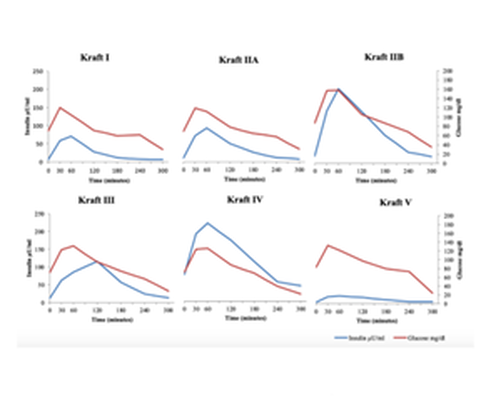|
A Kraft Test is a blood test used to identify a condition known as hyperinsulinemia. It is a picture of how your body responds to food, in particular glucose - the basic component of most of the carbohydrates we eat increasingly in our modern diets. When glucose enters the body it’s important that its concentration in our bloodstream is kept under control, so the body quickly responds to the glucose influx with a regulating hormone called *insulin*. Most of us associate insulin with a treatment for diabetes, and it is. But actually, everybody naturally produces insulin in the pancreas. Some of us need more insulin than others and the particular “pattern” of that response is very telling as to the status of your metabolic health. In fact, many medical professionals think it’s the most important blood test for metabolic health. The reason it is so important is because the test is an early-warning of chronic disease risk. A Kraft Test can reveal if the patient has a condition known as hyperinsulinemia, which is known to increase the risk of a host of conditions including diabetes but also hypertension, heart attack, stroke, neuropathy and even things like tinnitus, vertigo and hearing loss. In fact, Kraft took to calling hyperinsulinemia “occult diabetes” or “hidden diabetes”. In his original study*, Dr. Joseph Kraft, the doctor and pathologist who discovered these patterns, grouped the patterns he observed in patients into five broad groups. These patterns were observed after asking his patients to take a glucose drink while in a fasting state. This allowed him to isolate the behavior of insulin as it responds to glucose over the subsequent 3 hours and is almost exactly the same protocol you will follow to discover your Kraft Pattern. His discoveries were remarkable. He found that of patients who had normal blood glucose levels (about half the population in his study), and who therefore were thought to be in a “normal” or healthy metabolic state, 50% actually had hyperinsulinemia and a further 25% were borderline for the condition. Effectively these people had an early form of diabetes and didn’t even know it. They thought they were fine! The key insight a Kraft Test offers is in the pattern of insulin response to glucose consumption. But what do these patterns actually look like and what do they mean? Let’s take each one in turn. What follows are high-level descriptions and meaning of each Kraft Pattern as described by Crofts*. Pattern I
This is the pattern observed in normal metabolically healthy individuals. Note how the insulin responds to the consumption of glucose but does so in a moderate way and rapidly declines after it has done its job. Pattern IIA This pattern is observed in patients who have a “borderline” degree of insulin resistance. Here we see a higher fasting level of insulin (not a good sign) stronger initial insulin (post-glucose drink) concentration in the blood for the simple reason that more of it is needed to keep glucose under control. Pattern IIB This pattern is observed in patients who have what is called hyperinsulinemia - an early biomarker for diabetes risk. Here we once again see a higher fasting level of insulin. Importantly we also see an even stronger initial insulin (post- glucose drink) “spike” in the blood compared to those in Pattern IIA. Pattern III This pattern is also observed in patients who have hyperinsulinemia. Here again we see the characteristic higher fasting an post-glucose-drink insulin levels. But we also see a delayed “tail-off” in insulin as the hormone stays around longer in the blood. This is a more pronounced form of hyperinsulinemia and people with diabetes typically have this kind of pattern. Pattern IV A rarer pattern that some patients will present with. Here we see a very high fasting level of insulin, a non-delayed peak and then a long tail off. Again, this is likely to be a sign of diabetes. Pattern V Pattern V is actually a special case. Note how insulin stays very low throughout the test. This is because these individuals are likely Type 1 Diabetics. The opportunity to get this assessment is now and with new technology you can get a real time assessment at our clinic in Devon. *Detection of Diabetes Mellitus 'In Situ' (Occult Diabetes) - Joseph R. Kraft, M.D. Laboratory Medicine, Volume 6, Issue 2, 1 February 1975, Pages 10–22. Postprandial insulin assay as the earliest biomarker for diagnosing pre- diabetes, type 2 diabetes and increased cardiovascular risk - DiNicolantonio JJ, Bhutani J, OKeefe JH, et al. Open Heart 2017. Identifying hyperinsulinemia in the absence of impaired glucose tolerance: An examination of the Kraft database - Crofts C, Schofield G, Zinn C, Wheldon M, Kraft J. Diabetes Res Clin Pract. 2016 Aug.
0 Comments
Your comment will be posted after it is approved.
Leave a Reply. |
Taylormade
|
PERFORMANCE AND REHABILITATION CLINIC
Injury Management and Conditioning Specialist
Taylormade Rehab, 1 Belle Vue, Fenny Bridges, Honiton, Devon EX14 3BJ | 07800 824557 | 07855 386634
© 2019 Taylormade | Performance & Rehabilitation Clinic. Injury Management & Conditioning Specialists | Website design by brightblueC
© 2019 Taylormade | Performance & Rehabilitation Clinic. Injury Management & Conditioning Specialists | Website design by brightblueC


 RSS Feed
RSS Feed
